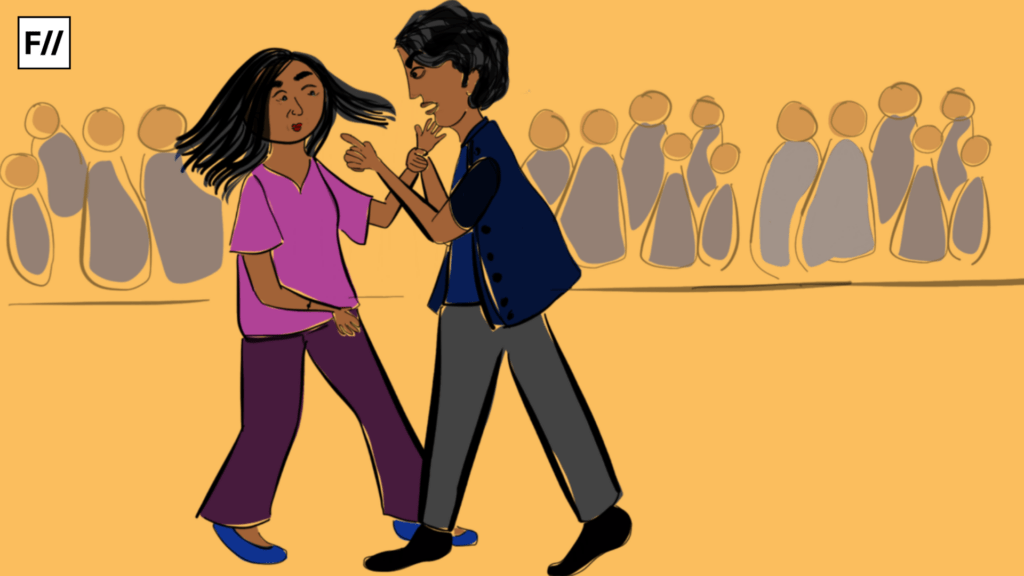As a result of Covid-19, South Bihar is witnessing an increase in bride trafficking cases similar to its northern counterparts. The rising poverty in the aftermath of Covid-19 has pushed residents of Vaishali, Muzaffarpur, Rohtas, and several other districts into selling their girls under the pretext of marriage. One of the worst affected districts is Rohtas, where minor girls are being trafficked to Rajasthan, about 1300 kilometers away.
“I should not be sold”
In June 2021, a seventeen-year-old girl Sulochna registered an FIR at the Rohtas police station, stating – “I should not be sold”. Sulochana’s marriage was arranged to a boy from Rajasthan last year by her mother Aarti Devi, maternal grandfather Mahesh Chowdhary, and maternal uncle Sagar Kumar Chowdhary. Sulochana’s father, Nagina Chowdhary, who works as a driver in Hyderabad, and her paternal grandparents did not approve of this marriage.
Usha Devi from Tilouthu’s Sevahi panchayat was also approached by another broker, Sangeeta, from her panchayat. Usha looks after her niece since both her parents have passed away. Thinking Usha’s niece would be a burden to her, Sangeeta came up with a proposal to get her niece married off in Rajasthan. “She said that the marriage would happen without ‘dowry-tilak’ and that, in return, we would get the money. I felt agitated. Why should we get our niece married in this way?” questioned Usha.
With the help of the village Sarpanch and a local non-government organisation in Tilouthu block in Rohtas, Sulochana’s grandmother was able to intervene and stop the marriage. Later, an FIR was registered at the Rohtas police station against Sulochana’s mother, maternal grandfather, and maternal uncle.

According to the FIR, Sulochana was sold to a person from Rajasthan for Rs 2.5 lakhs. Sulochana, the eldest of the three siblings, said, “Two weeks ago, the police took my mother to get her signature on some papers. She is now in jail with my maternal grandfather and maternal uncle.” This brave step by Sulochana was faced with vicious taunts by her relatives and neighbours for sending her mother and relatives to jail. It has severely impacted her studies, but support from her paternal grandparents has been her biggest strength.
Fight of many more Sulochanas in Rohtas
In Rohtas, there are several girls who have been betrayed by their loved ones. Last year in February, two minor orphaned sisters were sold for a mere Rupees Ten Thousand by their brother and sister-in-law, to a man in Rajasthan. Two women, Bunchia Kunwar from Baknaura village and Santoshi Devi from Samohta village in Rohtas helped arrange the deal.
“Such cases are not new in Rohtas but Covid-19 made it worse. Countless people lost their jobs, and the financial crisis made them see trafficking as an easy business. Recently, in November 2022, a girl from Nasriganj police station in Rohtas was freed from Neem Ka Thana in Sikar in Rajasthan. In this case, Sumitra Devi, a resident of Pipardih, Rohtas, had sold the girl for Rs 1,60,000.”
Vinod Kumar, Parivartan Vikas Sansthan
As soon as the news reached the local NGO, they intervened and rescued the girls. After the continuous increase in such incidences, Dharmendra Kumar, District Magistrate, Rohtas, formed an investigation team in February 2022, but the results have been nominal up till now.
According to Vinod Kumar, Parivartan Vikas Sansthan – a local NGO working on bride trafficking, “Such cases are not new in Rohtas but Covid-19 made it worse. Countless people lost their jobs, and the financial crisis made them see trafficking as an easy business. Recently, in November 2022, a girl from Nasriganj police station in Rohtas was freed from Neem Ka Thana in Sikar in Rajasthan. In this case, Sumitra Devi, a resident of Pipardih, Rohtas, had sold the girl for Rs 1,60,000.”
Temple wedding to avoid eyeballs
Akin to the norm followed in the Seemanchal area of Bihar, there are almost no public celebrations of such marriages in Rohtas as well. Reena Kumari, a member of the Sukanya Club, which is run for adolescent girls in Tilouthu, said, “Just by knowing where the wedding is taking place, one can tell if it is a case of trafficking. If it happens in a temple or a lodge, with no rituals at home, it is a sham.”

Often, the problems of poverty, especially for girls without parents, make it easier for traffickers to flourish. A pool of traffickers from across the states often works together, letting the information pass from one end to another.
Also Read: The Ugly Truth Of Bride Trafficking And Agrarian Labour In Haryana
In another case, Usha Devi from Tilouthu’s Sevahi panchayat was also approached by another broker, Sangeeta, from her panchayat. Usha looks after her niece since both her parents have passed away. Thinking Usha’s niece would be a burden to her, Sangeeta came up with a proposal to get her niece married off in Rajasthan. “She said that the marriage would happen without ‘dowry-tilak’ and that, in return, we would get the money. I felt agitated. Why should we get our niece married in this way?” questioned Usha.
Easier route for traffickers
Rohtas is well connected to other parts of the country due to its thriving agriculture-based economy. Due to this, the traffickers get easy access to every nook and cranny of the state. Besides bride trafficking, poor tribal girls in the district are also being trafficked for different reasons. 59 minor tribal girls were recently recovered from a train from Bihar to Nagpur in Maharashtra.
Due to Covid-19, new centres of trafficking have emerged even within the Rohtas district. According to Ankit Kumar, who runs a website titled ‘RohtasDistrict.com’, the hilly areas of Rohtas like Tilouthu, Rohtas, and Nauhatta block are now well connected with roads to NH-2C. This has made it easier for traffickers to reach these areas.
These girls were being trafficked to Nagpur on the pretext of free education. Laxman Uranv, the Sarpanch of Piparli, one of the tribal areas of the district, said, “Our people are simple. They were being duped in the name of education, and their girls were being taken away by outsiders, who were supported by brokers in the area. Now that it has been revealed, we are being careful.”
Due to Covid-19, new centres of trafficking have emerged even within the Rohtas district. According to Ankit Kumar, who runs a website titled ‘RohtasDistrict.com’, the hilly areas of Rohtas like Tilouthu, Rohtas, and Nauhatta block are now well connected with roads to NH-2C. This has made it easier for traffickers to reach these areas.
Kamlesh, a local journalist who has been continuously reporting on cases of bride trafficking, informed, “90 percent of the brides trafficked from Rohtas district go to Rajasthan and 10 percent to Muslim-dominated areas of Uttar Pradesh. The trafficked brides are usually sold for anything between Rupees Ten Thousand to Rupees Two and a Half Lakhs.”
Also Read: Bride Price: The Unsettling Impacts Of The Practice
According to the Census 2011, the literacy rate of Rohtas is 73.37 percent, way more than, the Seemanchal area of Araria, which is 55 percent , 52.24 percent in Katihar, 51.08 percent in Purnia, and 55.46 percent in Kishanganj. If we look at the literacy rate of women in these districts, it is only 45 percent in Seemanchal, whereas it is 62.97 percent in Rohtas. Education could be one of the reasons why more cases of bride trafficking are being reported and thus being fought in the Rohtas district of Southern Bihar as compared to the Seemanchal districts of Bihar.
The writer is a recipient of the Sanjoy Ghose Media Awards.




